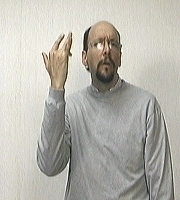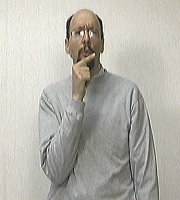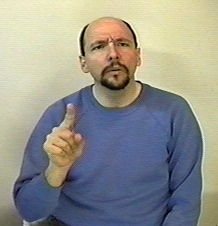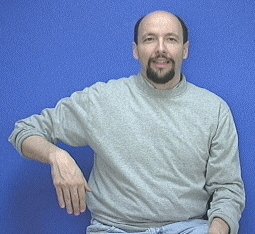Non-manual
Markers in ASL / NMM's
Also see:
Non-manual
Signals
Non-manual markers consist of the various facial expressions, head tilting,
shoulder raising, mouthing, and similar signals that we add to "signs" (such
as are used in American Sign Language) to create or
influence meaning.
The sign for non-manual markers is to fingerspell "NMM" but
people often do the sign for "expressions" to mean NMM's.
An examples of a non-manual marker:
1. Bringing your cheek and your shoulder closer together while tightening
the muscles in your cheek (as if you were smiling with half your face).
This is often abbreviated as "c-s" meaning "cheek to
shoulder." This non-manual marker is used with signs like,
"RECENT" and "THERE" to mean, "very recent"
and "right there (close)."
Speakers of English tend to inflect their voices to indicate they are
asking a question. Signers of ASL also inflect their questions, but instead
of using voice inflection we use non-manual markers.
For example:
YES/NO Question Expression:
When signing a question that can be answered "yes or no" you
raise your eyebrows and tilt your head forward a bit.
"WH-Q" Question Expression:
When signing a question involving "who, what, when, where, how, how
much, how many, which, or why" you use what is called a "wh"
question facial expression. The "wh" facial expression
"furrows" the eyebrows a bit and may tilt the head back a
bit--while the body might lean forward a bit.
Here are some examples of "wh" question expression:
 why
why
 who
who where
where
Nonmanual markers (NMMs) in American Sign Language (ASL) are essential facial expressions, head movements, and other body language cues that convey grammatical information. Here is a list of common nonmanual markers and their descriptions:
- Eyebrows Raised:
- Yes/No Questions: Raised eyebrows are used when asking yes/no questions.
- Conditional Clauses: Raised eyebrows are used to
indicate the conditional part of a sentence.
- Eyebrows Furrowed:
- Wh-Questions: Furrowed eyebrows are used when asking questions that begin with words like who, what, where, when, why, and how.
- Negation and Doubt: Furrowed eyebrows can indicate
negation or doubt.
- Head Nods:
- Affirmation: A nodding head indicates agreement or
affirmation.
- Affirmation: A nodding head indicates agreement or
affirmation.
- Head Shakes:
- Negation: A shaking head indicates negation or
disagreement.
- Negation: A shaking head indicates negation or
disagreement.
- Mouth Shapes:
- "oo": Indicates something small or diminutive.
- "mm": Indicates something regular, normal, or moderate.
- "cha": Indicates something large or big.
- "puffed cheeks": Can indicate something is very large, bulky, or intense.
- "th": Indicates carelessness or a lack of precision.
- "pursed lips": Can indicate intensity or seriousness.
- "gritted / barred teeth": Can indicate effort under
pressure, pain, or intensity.
- Eye Gaze:
- Directional Verbs: The direction of the gaze can
indicate the direction of an action or the subject of the conversation.
- Focus and Attention: Eye gaze can show where the
signer is directing their attention.
- Directional Verbs: The direction of the gaze can
indicate the direction of an action or the subject of the conversation.
- Cheek Puffing:
- Indicates intensity, size, or effort.
- Indicates intensity, size, or effort.
- Nose Wrinkling:
- Can indicate distaste or disapproval.
- Can indicate distaste or disapproval.
- Shoulder Raising:
- Indicates uncertainty or questioning.
- single cheek-to-shoulder indicates "very" or "just" as in "very
recent" or "just happened"
- Head Tilting:
- Used to emphasize a point or to indicate a question.
These nonmanual markers are crucial for understanding and conveying the full meaning of ASL signs, as they add grammatical and emotional context to the manual signs.
Dear Dr. Bill:I used your website to help deaf friends with vocabulary. I am an ASL/Deaf Studies Specialist. I also do computer graphics. I need to know where non-manuals came from? Who gave that idea as a developments. Are there any resources on history of non-manuals signals?Thank you, smileMelinda
If you wish to study "non-manual markers" in more depth you will likely find more resources by first researching "facial expressions," and "gestures."
Over at Youtube as part of the "Signs" channel (a sign clip repository
mainly used to embed sign examples into Lifeprint.com)
I have a clip of the following sentence:
"MOVIE YOU THINK LOUSY, what-NAME?"
In the comments section under that video an ASL Hero commented: You forgot the,
"What."
To which I replied: "I absolutely did "not" forget "what." In addition to signs done by the
hands ASL also uses "non-manual markers" (facial expressions, shoulder
raises, body shifts, head tilts, etc.) to create meaning. Look at my head
position and eyebrows as I do the sign glossed (written) as "what-NAME?"
Notice how my eyebrows are furrowed? That lowering of the eyebrows functions
to create a "WH"-type question and turns "NAME" into "what-NAME?" That is
why I specifically put the word "what" in lowercase and hyphenated it to the
uppercase word NAME -- to indicate that the concept is being shown as one
sign."
(Source:
https://youtu.be/2P4GAXmy6bo )
Question:
Are all non-manual aspects of signing considered "markers?"
Response:
If you use a strict definition of a marker as something that adds grammatical
information to some other linguistic unit -- then perhaps there are indeed
various facial expressions or body movements that do not add "grammatical"
information and instead simply add articulatory information. For example
the mouth position in NOT-YET may only be adding articulatory information and as
such it wouldn't be a non-manual marker -- intead it would be a non-manual
signal that helps distinguish this sign from the sign for LATE.
Let me put it this way:
Doing the sign NOT-YET with a slightly open mouth doesn't mark the sign with an
inflected meaning. It cause the sign to change from meaning "not yet" to
instead mean something like "not-quite-yet." The mouth configuration is
"just how the sign is done."
Slightly opening the mouth and placing the tongue over the bottom teeth so that
it touches the lower lip. This non-manual signal is used with the sign, "NOT-YET."
Using the non-manual signal helps distinguish the sign NOT-YET from
the sign LATE.
NOT-YET


However -- this is absolutely NOT worth arguing about.
If some folks want to call that mouth position an NMM will your life really be
benefited by trying to convince them it isn't?
Or maybe you should go do something nice for a stranger or homeless person
instead eh?
Notes:
*
Want to help support ASL University? It's easy:
DONATE (Thanks!)
* Another way to help is to buy something from Dr. Bill's "Bookstore."
* Want even more ASL resources? Visit the "ASL Training Center!" (Subscription
Extension of ASLU)
* Also check out Dr. Bill's channel:
www.youtube.com/billvicars
You can learn American Sign Language (ASL) online at American Sign Language University ™
ASL resources by Lifeprint.com © Dr. William Vicars